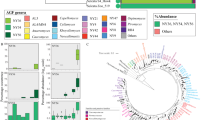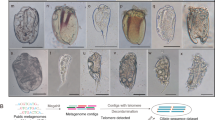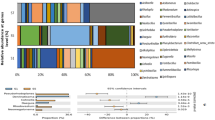Abstract
The phylogenetic diversity and community structure of members of the gut anaerobic fungi (AF) (phylum Neocallimastigomycota) were investigated in 30 different herbivore species that belong to 10 different mammalian and reptilian families using the internal transcribed spacer region-1 (ITS-1) ribosomal RNA (rRNA) region as a phylogenetic marker. A total of 267 287 sequences representing all known anaerobic fungal genera were obtained in this study. Sequences affiliated with the genus Piromyces were the most abundant, being encountered in 28 different samples, and representing 36% of the sequences obtained. On the other hand, sequences affiliated with the genera Cyllamyces and Orpinomyces were the least abundant, being encountered in 2, and 8 samples, and representing 0.7%, and 1.1% of the total sequences obtained, respectively. Further, 38.3% of the sequences obtained did not cluster with previously identified genera and formed eight phylogenetically distinct novel anaerobic fungal lineages. Some of these novel lineages were widely distributed (for example NG1 and NG3), whereas others were animal specific, being encountered in only one or two animals (for example NG4, NG6, NG7, and NG8). The impact of various physiological and environmental factors on the diversity and community structure of AF was examined. The results suggest that animal host phylogeny exerts the most significant role on shaping anaerobic fungal diversity and community composition. These results greatly expand the documented global phylogenetic diversity of members of this poorly studied group of fungi that has an important function in initiating plant fiber degradation during fermentative digestion in ruminant and non-ruminant herbivores.
Similar content being viewed by others
Log in or create a free account to read this content
Gain free access to this article, as well as selected content from this journal and more on nature.com
or
References
Altschul SF, Madden TL, Schaffer AA, Zhang J, Zhang Z, Miller W et al. (1997). Gapped BLAST and PSI-BLAST: a new generation of protein database search programs. Nucleic Acids Res 25: 3389–3402.
Bauchop T . (1979). Rumen anaerobic fungi of cattle and sheep. Appl Environ Microbiol 38: 148–158.
Bauchop T . (1989). Biology of gut anaerobic fungi. BioSystems 23: 53–64.
Bray JR, Curtis JT . (1957). An ordination of the upland forest communities of southern Wisconsin. Ecol Monog 27: 325–349.
Brookman JL, Mennim G, Trinci APJ, Theodorou MK, Tuckwell DS . (2000). Identification of characterization of anaerobic gut fungi using molecular methodologies based on ribosomal ITS1 and 18S rRna. Microbiology 146: 393–403.
Chen H, Hopper SL, Li XL, Ljungdahl LG, Cerniglia CE . (2006). Isolation of extremely AT-rich genomic DNA and analysis of genes encoding carbohydrate-degrading enzymes from Orpinomyces sp. strain PC-2. Curr Microbiol 53: 396–400.
Chen Y-C, Tsai S-D, Cheng H-L, Chien C-Y, Hu C-Y, Cheng T-Y . (2007). Caecomyces sympodialis sp. nov., a new rumen fungus isolated from Bos indicus. Mycolgia 99: 125–130.
Cheng YF, Edwards JE, Allison GG, Zhu W-Y, Theodorou MK . (2009). Diversity and activity of enriched ruminal cultures of anaerobic fungi and methanogens grown together on lignocellulose in consecutive batch culture. Bioresour Technol 100: 4821–4828.
Chernoff H, Lehmann EL . (1954). The use of maximum likelihood estimates in χ2 tests for goodness-of-fit. Ann Math Stat 25: 579–586.
Edwards JE, Kingston-Smith AH, Jimenez HR, Huws SA, Skot KP, Griffith GW et al. (2008). Dynamics of initial colonization of nonconserved perennial ryegrass by anaerobic fungi in the bovine rumen. FEMS Microbiol Ecol 66: 537–545.
Fliegerova K, Hodrova B, Voigt K . (2004). Classical and molecular approaches as a powerful tool for the characterization of rumen polycentric fungi. Folia Microbiol 49: 157–164.
Good IJ . (1953). The population frequencies of species and the estimation of population parameters. Biometrika 40: 237–264.
Griffith GW, Ozkose E, Theodorou MK, Davies DR . (2009). Diversity of anaerobic fungal populations in cattle revealed by selective enrichment culture using different carbon sources. Fungal Ecol 2: 87–97.
Hibbett DS, Binder M, Bischoff JF, Blackwell M, Cannon PE, Eriksson OE et al. (2007). A higher-level phylogenetic classification of the Fungi. Mycol Res 111: 509–547.
Ho YW, Barr DJS . (1995). Classification of anaerobic gut fungi from herbivores with emphasis on rumen fungi from Malaysia. Mycologia 87: 655–677.
Ley RE, Hamady M, Lozupone C, Turnbaugh PJ, Ramey RR, Bircher JS et al. (2008). Evolution of mammals and their gut microbes. Science 320: 1647–1651.
Li X-L, Chen H, Ljungdahl LG . (1997a). Two cellulases, CelA and CelC, from the polycentric anaerobic fungus Orpinomyces strain PC-2 contain N-terminal docking domains for a cellulase-hemicellulase complex. Appl Environ Microbiol 63: 4721–4728.
Li XL, Chen H, Ljungdahl LG . (1997b). Monocentric and polycentric anaerobic fungi produce structurally related cellulases and xylanases. Appl Environ Microbiol 63: 628–635.
Liu C, Whittaker RJ, Ma K, Malcolm JR . (2007). Unifying and distinguishing diversity ordering methods for comparing communities. Popul Ecol 49: 89–100.
Ljungdahl LG . (2008). The cellulase/hemicellulase system of the anaerobic fungus orpinomyces PC-2 and aspects of its use. Ann NY Acad Sci 1125: 308–321.
Lowe SE, Theodorou MK, Trinci APJ . (1987). Cellulases and xylanase of an anaerobic rumen fungus grown on wheat straw, wheat straw holocellulose, cellulose, and xylan. Appl Environ Microbiol 53: 1216–1223.
Mackie R, Rycyk M, Reummler R, Aminov R, Wikelski M . (2004). Biochemical and microbiological evidence for fermentative digestion in free-living land iguanas and marine iguanas on the Galapagos archipelago. Physiol Biochem Zool 77: 127–138.
Nicholson MJ, McSweeney CS, Mackie RI, Brookman JL, Theodorou MK . (2009). Diversity of anaerobic gut fungal populations analysed using ribosomal ITS1 sequences in faeces of wild and domesticated herbivores. Anaerobe. In Press: doi:10.1016/j.anaerobe.2009.1005.1003.
Nilsson RH, Kristiansson E, Ryberg M, Hallenberg N, Larsson K-H . (2008). Intraspecific ITS variability in the kingdom Fungi as expressed in the international sequence databases and its implications for molecular species identification. Evol Bioinform Online 4: 193–201.
Orpin CG . (1975). Studies on the rumen flagellate Neocallimastix frontalis. J Gen Microbiol 91: 249–262.
Orpin CG . (1977). The occurrence of chitin in the cell walls of the rumen organism Neocallimstix frontalis, Piromonas communis, and Sphaeromonas communis. J Gen Microbiol 99: 215–218.
Orpin CG . (1994). Anaerobic fungi: taxonomy, biology, and distribution in nature. In: Mountfort DO, Orpin CG (eds). Anaerobic Fungi: Biology, Ecology, and Function. Marcel Dekker Inc.: New York, USA, pp 1–45.
Ozkose E, Thomas BJ, Davies DR, Griffith GW, Theodorou MK . (2001). Cyllamyces aberensis gen. nov. sp. nov., a new anaerobic gut fungus with branched sporangiophores isolated from cattle. Can J Bot 79: 666–673.
Philips MW, Gordon GLR . (1989). Growth characteristics on cellobiose of three different anaerobic fungi isolated from the ovine rumen. Appl Environ Microbiol 55: 1695–1702.
Plackett RL . (1983). Karl Pearson and the Chi-squared test. Int Stat Rev 51: 59–72.
Posada D . (2008). jModelTest: phylogenetic model averaging. Mol Biol Evol 25: 1253–1256.
Raghothama S, Eberhardt RY, Simpson P, Wigelsworth D, White P, Hazlewood GP et al. (2001). Characterization of a cellulome dockerin domain from the anaerobic fungus Piromyces equi. Nat Struct Biol 8: 775–778.
Schloss PD, Westcott SL, Thomas R, Hall JR, Hartmann M, Hollister EB et al. (2009). Introducing mothur: open-source, platform-independent, community-supported software for describing and comparing microbial communities. Appl Environ Microbiol 75: 7537–7541.
Shannon P, Markiel A, Ozier O, Baliga NS, Wang JT, Ramage D et al. (2003). Cytoscape: a software environment for integrated models of biomolecular interaction networks. Genome Res 13: 2498–2504.
Talavera G, Castresana J . (2007). Improvement of phylogenies after removing divergent and ambiguously aligned blocks from protein sequence alignments. Syst Biol 56: 564–577.
Teunissen MJ, Op den Camp HJ . (1994). Anaerobic fungi and their cellulolytic and xylanolytic enzymes. Antonie van Leeuwenhoek 63: 63–76.
Thareja A, Puniya AK, Goel G, Nagpal R, Sehgal J, Singh PK et al. (2006). In vitro degradation of wheat straw by anaerobic fungi from small ruminants. Arch Anim Nutr 60: 412–417.
Theodorou MK, Brookman J, Trinci A . (2005). Anaerobic fungi. In: Makkar HP, McSweeney CS (eds). Methods in Gut Microbial Ecology for Ruminants. Springer: Dordrech, The Netherlands.
Thompson JD, Gibson TJ, Pleiomiak F, Jeanmougin F, Higgnins DG . (1997). The ClustalX interface: flexible strategies for multiple sequence alignment aided by quality analysis tool. Nucleic Acids Res 25: 4876–4882.
Tuckwell DS, Nicholson MJ, McSweeney CS, Theodorou MK, Brookman JL . (2005). The rapid assignment of ruminal fungi to presumptive genera using ITS1 and ITS2 RNA secondary structures to produce group-specific fingerprints. Microbiology 151: 1557–1567.
Williams AG, Orpin CG . (1987a). Polysaccharide-degrading enzymes formed by three species of anaerobic rumen fungi grown on a range of carbohydrate substrates. Can J Microbiol 33: 418–426.
Williams AG, Orpin CG . (1987b). Glycoside hydrolase enzymes present in the zoospores and vegetative growth stages of the rumen fungi Neocallimastix patriciarum, Piromonas communis, and an unidentified isolate grown on a range of carbohydrates. Can J Microbiol 33: 427–434.
Youssef NH, Elshahed MS . (2009). Diversity rankings among bacterial lineages in soil. ISME J 3: 305–313.
Acknowledgements
We thank Sue Haley and Dr Jennifer D’Agostino for help with sampling. This work was supported by grants from the Oklahoma Bioenergy Center, and NSF EPSCoR award EPS 0814361.
Author information
Authors and Affiliations
Corresponding author
Additional information
Supplementary Information accompanies the paper on The ISME Journal website
Rights and permissions
About this article
Cite this article
Liggenstoffer, A., Youssef, N., Couger, M. et al. Phylogenetic diversity and community structure of anaerobic gut fungi (phylum Neocallimastigomycota) in ruminant and non-ruminant herbivores. ISME J 4, 1225–1235 (2010). https://doi.org/10.1038/ismej.2010.49
Received:
Revised:
Accepted:
Published:
Issue date:
DOI: https://doi.org/10.1038/ismej.2010.49
Keywords
This article is cited by
-
Core-predominant gut fungus Kazachstania slooffiae promotes intestinal epithelial glycolysis via lysine desuccinylation in pigs
Microbiome (2023)
-
Diversity and functional prediction of fungal communities in different segments of mongolian horse gastrointestinal tracts
BMC Microbiology (2023)
-
Colonization and development of the gut microbiome in calves
Journal of Animal Science and Biotechnology (2023)
-
The effects of Selenohomolanthionine supplementation on the rumen eukaryotic diversity of Shaanbei white cashmere wether goats
Scientific Reports (2023)
-
Patterns and determinants of the global herbivorous mycobiome
Nature Communications (2023)



